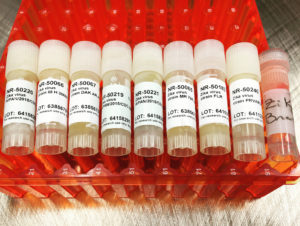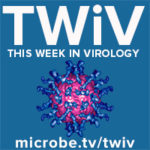![]()
 Hosts: Vincent Racaniello, Dickson Despommier, Alan Dove, and Rich Condit
Hosts: Vincent Racaniello, Dickson Despommier, Alan Dove, and Rich Condit
The latest Zika virus news from the ConTWiVstadors, including a case of female to male transmission, risk of infection at the 2016 summer Olympics, a DNA vaccine, antibody-dependent enhancement by dengue antibodies, and sites of replication in the placenta.
Click arrow to play
Download TWiV 399 (75 MB .mp3, 103 min)
Subscribe (free): iTunes, RSS, email
Become a patron of TWiV!
Links for this episode
- Zika virus disease in the US (CDC) 5:45
- Female to male Zika virus transmission (CDC) 7:30
- Zika virus in female genital tract (Lancet) 9:00
- Zika virus transmission in Utah (CDC and NYTimes) 14:45
- Olympic Zika virus risk (CDC) 18:20
- 15 companies on Zika virus vaccines (WSJ) 24:25
- Zika virus DNA vaccine in mice (Nature) 24:50
- Zika virus disease in Colombia (NEJM) 35:40
- Dengue virus antibody dependent enhancement of Zika virus (PNAS) 39:40
- Zika virus antibodies enhance dengue virus disease (Science) 44:05
- Zika virus in human placenta and developing brain (bioRxiv) 48:20
- Zika virus targets different human placenta cells (Cell Host Microbe) 53:55
- Letters read on TWiV 399 1:02:25
Timestamps by Jennifer. Thanks!
This episode is sponsored by CuriosityStream. Get two months free when you sign up at curiositystream.com/microbe and use the promo code MICROBE 1:02:25
Weekly Science Picks 1:31:35
Alan – CDC postmortem on Ebolavirus outbreak
Rich – Refutations to anti-vaccine memes (Twitter, Facebook)
Dickson – History of urbanization
Vincent – How to cut subject from background in Photoshop
Listener Picks
Marion – Skeptics Guide to the Universe podcast
Jennie – Leatherback turtles in Costa Rica
Send your virology questions and comments to twiv@microbe.tv


My main issue with the “Dengue virus antibody dependent enhancement of Zika virus” story, is that while they’re saying there are ‘high levels of cross-neutralization to zika virus’, they don’t show what the neutralization titer is to the DENV serotypes
So if you call a Zika neut50 titer of 500 (serum dilution factor) high, that is meaningless without knowing what the neutralization titer to dengue is (basically, it’s ‘high’ compared to what? DENV neut titers that soon after infection can be in the tens of thousands). If someone who previously had a primary DENV1 infection has a DENV1 neut50 titer of 3000 and the neut50 against DENV2-4 (due to cross neutralization) is 1000, then a zika neut50 titer of 500 no longer seems ‘high’ and is lower than the other serotypes (suggesting cross-neutralization/protection in nature is unlikely). Importantly this would suggest that cross-neutralization of DENV immune sera to Zika is less than that to the other DENV serotypes
Additionally, in the DENV community, immune sera is considered convalescent after at least 6 months. There is a high degree of antibody cross-reactivity elicited following infection (which is why individuals are protected to other serotypes in the short-term), but this wanes substantially over the course of a year (leading to susceptibility). At this point, the majority of the antibodies that remain (and are sustained in circulation for 30+ years!) are type-specific, meaning the neutralizing antibodies are onlyspecific to the infecting serotype (which provides subsequent protection against that infecting serotype), but does not protect against the remaining serotypes.
So the ‘convalescent’ sera used in the paper that is only 37-100 days (!) post-infection, not surprisingly is flavi-cross neutralizing. And again, this ‘high’ neutralization to Zika, is meaningless without knowing what the neutralization is to the other DENV serotypes (this sera has a lot going on in it, maybe it also has a ‘high’ neutralization titer to influenza!)
Here is a recent paper (http://mbio.asm.org/content/7/4/e01123-16) that shows for convalescent sera (DENV1-4 and secondary infection sera), the neutralization titers against all five viruses, and shows there is surprisingly little cross-neutralization (Zika neut titers are almost always lower than that of the other serotypes).
Additionally, the Nature Immunology paper (http://www.nature.com/ni/journal/vaop/ncurrent/pdf/ni.3515.pdf) shows the same thing, where while some DENV convalescent (6+ months post-infection) immune sera can neutralization Zika (Figure 2b) it is far less compared to DENV neut titers.
I’m sure this was rambling and not very eloquent, but I hope I was able to highlight my point. After Mehul’s critique of the BioArchive paper discussed here, I was surprised to see the lack of these controls (that he so strongly demanded in Sharon’s paper) in his own paper.